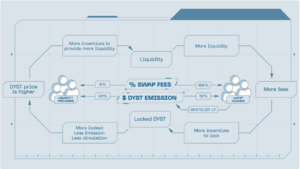Dystopia
Dystopia is a decentralized exchange and automated market maker for efficient yield farming. It was founded by belbix, who also founded the Tetu protocol. Dystopia was designed to provide users with efficient token swaps and large liquidity volumes.
Dystopia uses game theory principles to give users great control over their rewards. The protocol ensures that yield farming rewards depend not merely on the amount of capital staked but on the collective actions of stakers in the protocol.
Dystopia Swap
Dystopia Swap was built to reward users with emissions and swap fees. Swap fees on the exchange are as low as 0.05%, making Dystopia one of the most efficient DeFi swapping protocols. Liquidity providers on Dystopia swaps get incentivized with DYST emissions rather than swap fees.
Dystopia Swap was built on the Polygon network, and users can swap supported stablecoins and volatile assets. Users can add liquidity, lock DYST tokens to earn governing rights, and migrate liquidity pool tokens to another protocol.
On Dystopia swap, liquidity providers can provide liquidity in stable or volatile pools. For stable pools, liquidity providers get a relatively lower APR than volatile pools. However, liquidity providers who choose volatile pools are exposed to the risk of impermanent loss.
DYST and veDYST
DYST is the ticker symbol for the Dystopia token, while veDYST is the governance token. Users can lock their DYST tokens to earn veDYST. While DYST is a fungible asset, veDYST is non-fungible. However, veDYST grants users voting power.
veDYST holders can vote for selected Dystopian pools to get boosted emissions. As a reward for their participation in governance, veDYST holders earn fees from the liquidity pools.
veDYST lockers get 100% of swap fees from liquidity pairs they voted for. This spurs veDYST holders to vote for the gauges that generate the highest amount of swap fees on the protocol.
Ve (3,3)
Dystopia’s ve (3,3) design mirrors the staking and reward system of the Solidly protocol. This design was created by Andre Cronje and Daniele Sestagalli, two DeFi advocates. The Ve (3,3) mechanism combines features of multiple decentralized protocols to achieve optimal capital efficiency.
Ve stands for vested escrow. The Ve framework is utilized in the Curve and Convex protocols. The vote escrow framework encourages users to lock their tokens in liquidity pools for a specific period. This gives appetizing rewards to lockers but could result in low liquidity in DeFi pools.
The (3,3) model was created by Olympus DAO, encouraging users to stake as many tokens as possible. The disadvantage of this, however, is its reward mechanism. As the emission rate increases, the token’s value decreases.
Dystopia utilizes a reward system in its liquidity pools that harmonizes the Ve and 3,3 mechanisms. Thus, the goal of Dystopia is to create an ecosystem that maximizes rewards from the Ve system while maintaining deep liquidity from the 3,3 architecture.
Dystopia’s Governance Model
Dystopia’s governance system gives all holders of veDYST the right to support gauges. Users who vote for a gauge receive all the swap fees from the vault they voted for. Users can also boost their yield farming rewards by merging the veDYST NFTs. This gives them more voting power and more incentives from pools.
The governance model also supports bribes for gauges. When a bribe is attached to a gauge, it makes the gauge more attractive. Users who vote for gauges with bribes get twofold rewards. One from the swap fees received from the gauge or pool and the other from the bribe provided. Dystopia’s governance and reward model ensures that active participants get rewarded for their activities, and rewards flow in from multiple streams.
Dystopia’s Security
After its fork from Solidly’s audited smart contracts, Dystopia further tightened the protocol’s security by implementing some upgrades. Dystopia’s governance wallet uses a 3/6 Gnosis multi-sig account, making it impossible for one malicious actor to manipulate decentralized activities on the protocol.
The smart contract has 1903 lines of code, with 100% coverage. The optimal code coverage score of Dystopia’s contract indicates that the protocol is secure, and the chances of bearing code vulnerabilities are very low.
